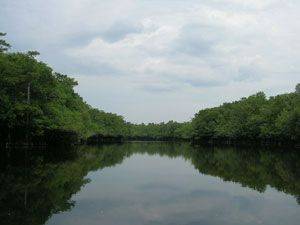When you hear about the Apalachicola River, do you think about fishing? If you do, the fish that you think of first likely include Largemouth bass, bream, catfish, Sunshine bass, and stripers. But, how about Gag grouper? You should think of them, too. Grouper may not live in the river, but they definitely depend on the river, as do so many others of your favorite saltwater targets, like speckled Sea trout, Red drum, and flounder.
The most obvious effects are in the estuary, where the river’s freshwater mixes with the saltwater of the Gulf. In the swamps and salt marshes of the lower river and in Apalachicola Bay, many species of baitfish and game fish either reproduce or spend a substantial portion of their early lives feeding on the rich smorgasbord of marine life that thrives there. The crawfish in the swamps, the shrimp, anchovies, the mullet in the bay, and the menhaden in nearby Gulf waters provide a rich repast for juvenile and adult game fish, who at the same time find shelter from the voracious predators of the open Gulf. About 90% of important finfish species spend some part of their lives in the estuary or nearby coastal waters, so the health of these waters is essential to maintaining healthy stocks of the fish you want most to bring home to the table.
And the Apalachicola isn’t just any estuary. This mighty river drains a watershed of nearly 20,000 square miles, much of which is not yet developed. From this drainage the river sends forth over 1/3 of the freshwater that the eastern gulf receives, and this water is full of healthful nutrients produced by natural processes in the swamps and pristine wetlands surrounding the river. The result is a plume of essential nutrients pulsing southward into the Gulf of Mexico.
Dubbed the “Green River” by Dr. Felicia Coleman, the Director of the FSU Marine Lab who is studying it extensively in the wake of the Gulf oil spills, the plume extends two or three hundred miles offshore in a path that roughly parallels the Florida coastline. This plume provides nutrition, improved habitat, and improved reproductive conditions for many of our favorite marine game fish, including groupers, snappers, amberjack, and triggerfish. And unlike the Mississippi River, which generates a similarly-sized plume of man-made nutrients (and synthetic chemicals) that overwhelm life in the central Gulf, producing the famous Dead Zone, the natural nutrients in the Apalachicola River are essential to marine life in the eastern Gulf. Our Green River is very much a Live Zone!
The key concern for fish stocks is not the quality of the water in the Apalachicola River, but its quantity. You may have heard recently about how the lack of freshwater flow in the river is killing off the Apalachicola Bay oysters, and that’s true: diseases and predators (think conchs and whelks) that kill oysters thrive in salty waters. When river flow is higher, the bay stays fresher and the oysters thrive.
The link between higher freshwater flows and finfish stocks deep in the Gulf is just a bit more complicated. When spring rains and snowmelt bring flood conditions to the River it overflows its banks and courses through the creeks and sloughs into the swamps that form its floodplain. At times, as much as 60% of the water may be outside the banks, bringing new life to the vast and varied ecosystem that surrounds the river. And then when the water level drops in summer and fall, the water flows out of the swamps and into the river and bay, carrying the nutrients that are consumed at the bottom of the food chain, and which ultimately feed Gulf groupers.
There are problems with this fabulous fish-feeding mechanism that nature created for us. Fifty years of dredging left the river surface lower than its natural state, making it more difficult for the water to get into the floodplain. And that same dredging (halted by the State of Florida’s permit denial in 2005) brought up many thousands of cubic yards of sand, most of which was deposited in streamside spoil areas. River currents moved the sand around, blocking the openings to many of the small creeks and sloughs. Water fails to get over these sand-plugs in the spring and summer, leaving the swamp denizens gasping of thirst.
And the water that does get in often fails to get back out, as the mouths of many sloughs and creeks are sand-plugged as well. The mouths of some sloughs have now been dry so long that they have re-vegetated, which is science-speak for “trees are growing there now.” So the plume is neither as rich nor as large as it was 80 years ago before upstream locks, dams, and dredging dramatically altered and reduced the river’s flow. Nobody knows how Gulf fish stocks will fare should flows decline even further.
But for now the Green River still flows, and it remains the single most important source of additional nutrition in the eastern Gulf. So when you think about Apalachicola River fishing, think grouper!
Doug Wakeman is Senior Policy Analyst for Apalachicola Riverkeeper which is a member-supported organization dedicated to the restoration and protection of the Apalachicola River and Bay. Visit us on the web at www.apalachicolariverkeeper.org, or call us at 850-653-8936, or find us on Facebook.

